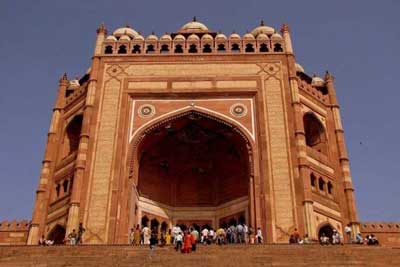
Akbar the great, the third Mughal emperor, who reigned from 1556 to 1605, was a follower of Sheikh Salim Chisti, a holy man, who lived in the region of Sikri near Agra. As predicted by the Sheikh, Akbar, the heirless Emperor till then, was gifted with the birth of his son, Jahangir, who was born in the village of Sikri in 1569. Consequently, the Emperor, to express his gratitude to the holy man, constructed a religious compound in the village to commemorate the Sheikh.

After the celebration of Jahangir's second birthday and his successive victories over Chittor and Ranthambore, Akbar celebrated by laying the foundation of a new walled capital in the vicinity of the village, 37 km west of Agra, which was named Fatehpur. In 1573, after the conquest of Gujarat, the new capital came to be known as Fatehpur Sikri, the city of victory, in order to distinguish it from other similarly named towns.


Situated on a rocky ridge, Fatehpur Sikri is 3 km in length and 1 km wide. The three sides of the palace city are surrounded by a 6 km (3.7 mi) wall, while the fourth side is bordered by a lake. All the buildings at Fatehpur Sikri palace-city complex are made of locally quarried red sandstone, known as 'Sikri sandstone'.
It is believed by the contemporary historians, Akbar personally took great interest in the building of Fatehpur Sikri complex and he planned the buildings on Persian principles. But, the monuments of Fatehpur Sikri reflect the assimilation of diverse regional architectural influences, because indigenous craftsmen were used for the construction of the buildings and the influences of Hindu and Jain architecture are reflected in the structures along with Islamic elements.
The central portico of the complex consists of three arched entrances. The largest arched way in the centre, is locally known as the Horseshoe Gate, since the local people customarily nail horseshoes on its large wooden doors for good luck. There is a deep well to the left, outside the giant steps of the Buland Darwaza.


The gigantic Buland Darwaza at Fatehpur Sikri is 55 m (180 ft) high from the ground level and accessible by 42 steps. The gate was added later as an arch of triumph to commemorate Akbar's successful Gujarat campaign, around five years after the completion of the mosque c.1576-1577. Considered to be the highest gateway in the world, Buland Darwaza exemplifies one of the finest architecture of Mughal era. It took nearly 12 years to make the highest gateway.
Made of red and pale yellow-brown, Sikri Sandstone, the Buland Darwaza towers above the courtyard of the mosque inside. The symmetrical structure is topped by large open-fronted kiosks, which are chhatris (canopy), echoing the early Mughal design with simple ornamentation, carved verses from the Koran and towering arches. At the top center, it includes terrace edge gallery-kiosks on the roof, stylized parapet regularly spaced squared openings for shooting through, with inlay decorative works with white and black marble. The main arch is placed in the centre of three projecting sides and topped by a dome. The central arch has three tiers with rows of smaller arches and flat brackets.


On the eastern archway of the Buland Darwaza, there is a Persian inscription depicting Akbar’s conquest over Uttar Pradesh and the victory in Gujarat in 1601. The central face of the colossal Darwaza bears an inscription describing Akbar's religious openness. On the main gateway an Islamic inscription written in Persian indicates the advice of Isa (Jesus) to his followers, not to consider the world as a permanent home. Apart from that, verses from the Quran have also been carved along the top, in the Naskh (script), drawn by Khwaja Hussain Chishti, a disciple of Sheikh Salim Chishti.

However, within a short time, Buland Darwaza lost its eminence, as Fatehpur Sikri was abandoned and the capital was moved to Lahore in 1585.